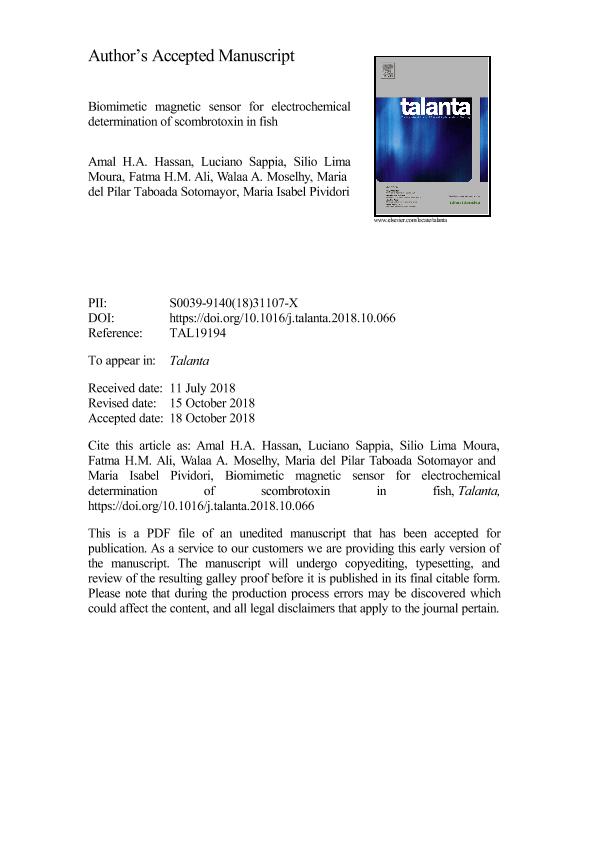Mostrar el registro sencillo del ítem
dc.contributor.author
Hassan, Amal H. A.
dc.contributor.author
Sappia, Luciano David

dc.contributor.author
Moura, Silio Lima
dc.contributor.author
Ali, Fatma H. M.
dc.contributor.author
Moselhy, Walaa A.
dc.contributor.author
Sotomayor, María del Pilar Taboada
dc.contributor.author
Pividori, María Isabel
dc.date.available
2020-11-24T16:28:28Z
dc.date.issued
2019-03
dc.identifier.citation
Hassan, Amal H. A.; Sappia, Luciano David; Moura, Silio Lima; Ali, Fatma H. M.; Moselhy, Walaa A.; et al.; Biomimetic magnetic sensor for electrochemical determination of scombrotoxin in fish; Elsevier Science; Talanta; 194; 3-2019; 997-1004
dc.identifier.issn
0039-9140
dc.identifier.uri
http://hdl.handle.net/11336/118883
dc.description.abstract
This work addresses a novel, rapid and cost-effective approach for the electrochemical sensing of scombrotoxin (histamine) in fish based on magnetic molecularly imprinted polymer (magnetic-MIP). The histamine magnetic-MIP was synthesized by the core-shell method using histamine as a template, and 2-vinyl pyridine as functional monomer. The magnetic-MIP was characterized by TEM, SEM, and confocal microscopy. Additionally, the binding capacity of magnetic-MIP towards histamine was investigated and compared with magnetic non-molecularly imprinted polymer (magnetic-NIP). This biomimetic material merged the advantages of MIPs and magnetic particles (MPs), including low cost of production, stability, high binding capacity and can be easily separated by the aid of a permanent magnet. The magnetic-MIP was integrated into magneto-actuated electrodes for the direct electrochemical detection of histamine preconcentrated from fish samples. The results revealed that this approach succeeded in the preconcentration and determination of histamine with a LOD as low as 1.6 × 10−6 mg L−1, much lower than the index for fish spoilage (50 mg kg−1) accordingly to the legislation. Furthermore, the analytical performance was validated for the determination of histamine in scombroid fish samples with recovery values ranging from 96.8 to 102.0 %, confirm so it can be applied easily for routine food examination.
dc.format
application/pdf
dc.language.iso
eng
dc.publisher
Elsevier Science

dc.rights
info:eu-repo/semantics/openAccess
dc.rights.uri
https://creativecommons.org/licenses/by-nc-sa/2.5/ar/
dc.subject
ELECTROCHEMICAL DETERMINATION
dc.subject
FISH
dc.subject
FOOD SAFETY
dc.subject
HISTAMINE
dc.subject
MAGNETIC-MIP
dc.subject
SCOMBROTOXIN
dc.subject.classification
Nano-materiales

dc.subject.classification
Nanotecnología

dc.subject.classification
INGENIERÍAS Y TECNOLOGÍAS

dc.title
Biomimetic magnetic sensor for electrochemical determination of scombrotoxin in fish
dc.type
info:eu-repo/semantics/article
dc.type
info:ar-repo/semantics/artículo
dc.type
info:eu-repo/semantics/publishedVersion
dc.date.updated
2020-11-13T20:43:14Z
dc.journal.volume
194
dc.journal.pagination
997-1004
dc.journal.pais
Países Bajos

dc.journal.ciudad
Amsterdam
dc.description.fil
Fil: Hassan, Amal H. A.. Universitat Autònoma de Barcelona; España. Beni suef University; Egipto
dc.description.fil
Fil: Sappia, Luciano David. Universitat Autònoma de Barcelona; España. Consejo Nacional de Investigaciones Científicas y Técnicas. Centro Científico Tecnológico Conicet - La Plata. Instituto de Investigaciones Fisicoquímicas Teóricas y Aplicadas. Universidad Nacional de La Plata. Facultad de Ciencias Exactas. Instituto de Investigaciones Fisicoquímicas Teóricas y Aplicadas; Argentina
dc.description.fil
Fil: Moura, Silio Lima. Universitat Autònoma de Barcelona; España
dc.description.fil
Fil: Ali, Fatma H. M.. Beni Suef University; Egipto
dc.description.fil
Fil: Moselhy, Walaa A.. Beni Suef University; Egipto
dc.description.fil
Fil: Sotomayor, María del Pilar Taboada. Universidade Estadual Paulista Julio de Mesquita Filho. Faculdade de Engenharia.; Brasil
dc.description.fil
Fil: Pividori, María Isabel. Universitat Autònoma de Barcelona; España
dc.journal.title
Talanta

dc.relation.alternativeid
info:eu-repo/semantics/altIdentifier/doi/http://dx.doi.org/10.1016/j.talanta.2018.10.066
dc.relation.alternativeid
info:eu-repo/semantics/altIdentifier/url/https://www.sciencedirect.com/science/article/abs/pii/S003991401831107X
Archivos asociados
